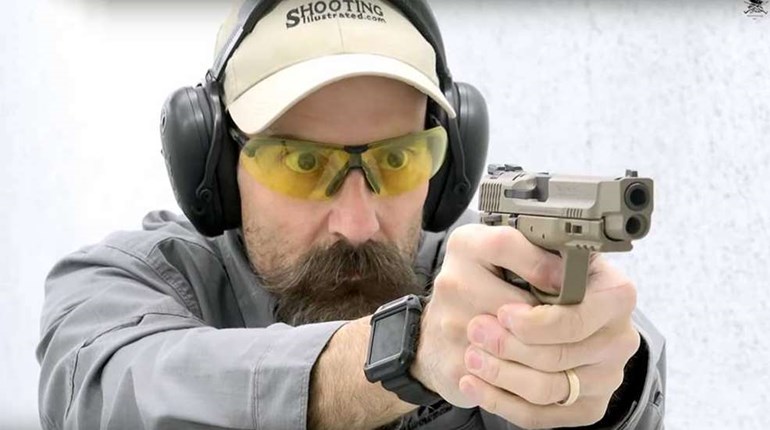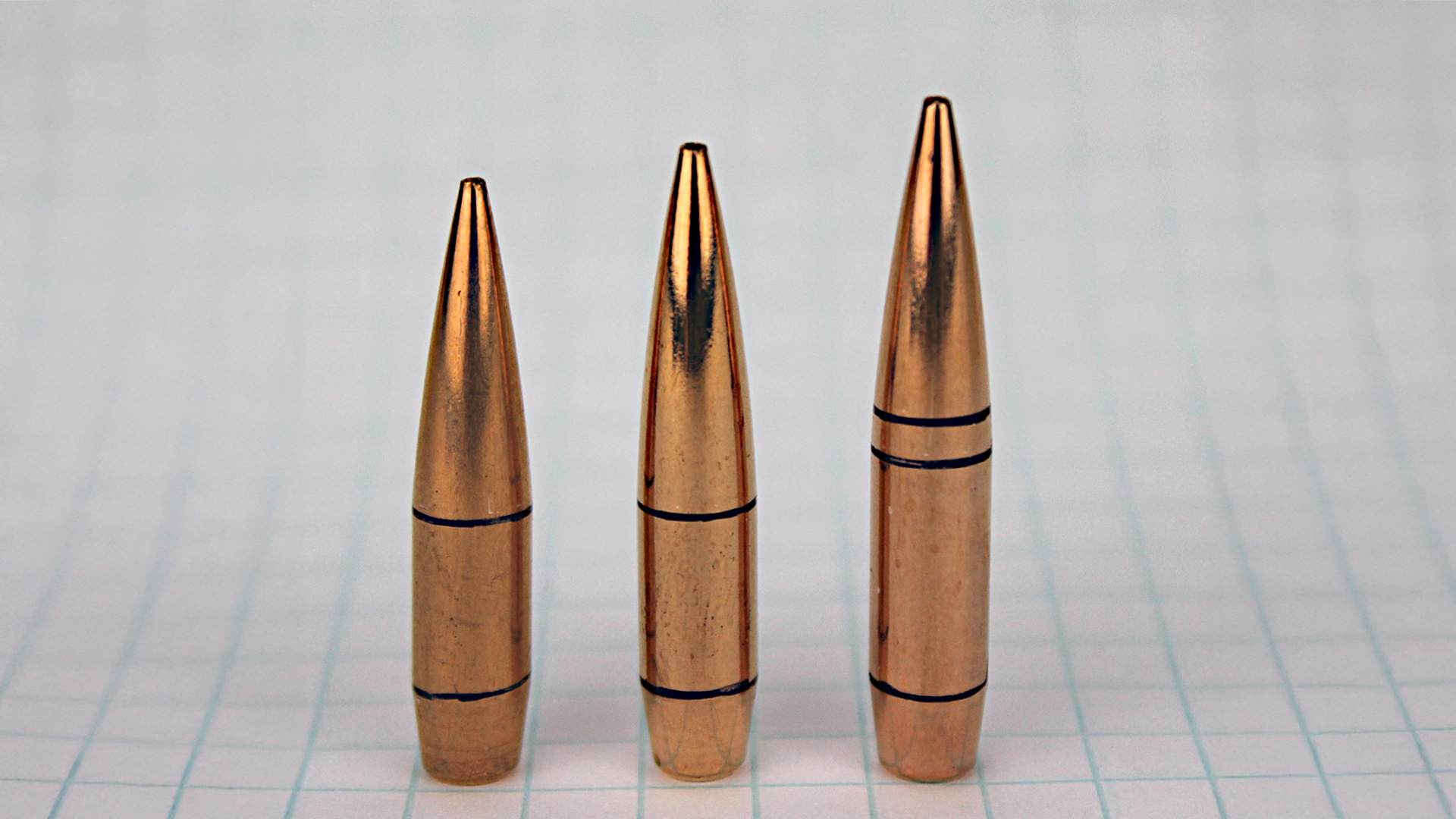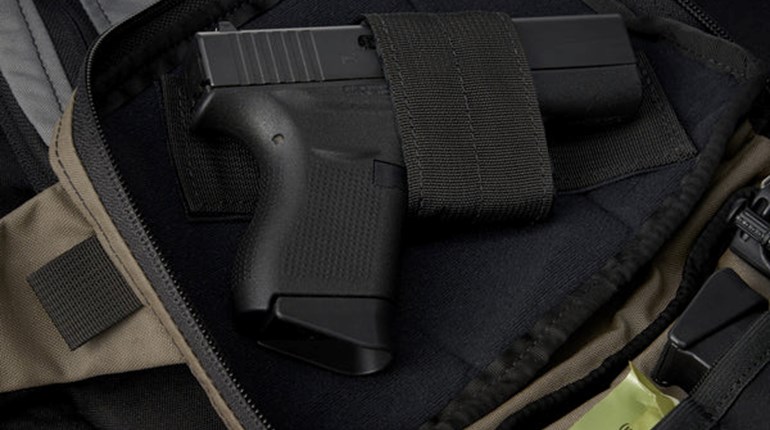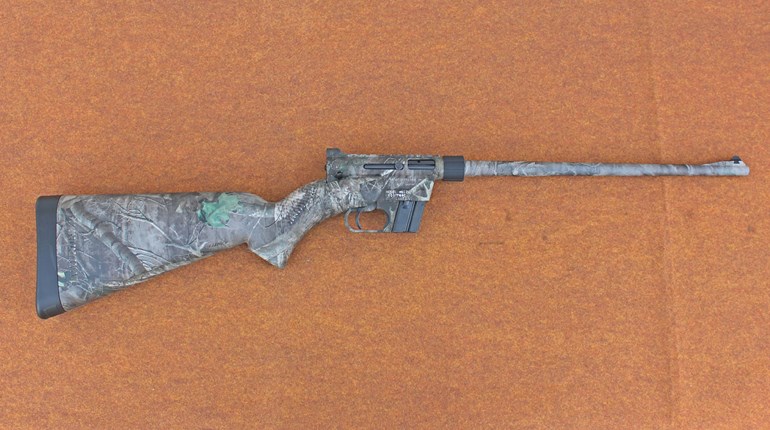
The Old Timer dropped the M1 rifle back on the counter as if it had burned his hands. "Listen, sonny," said he, wagging a grimy index finger under my nose. "That ain't now National Match (NM) rifle! I've been shooting since 'fore you was born and I've got two National Match Springfields at home. They got special polished bolts, fancy stocks, star-gauged barrels, and a lot of other fixin's. These idiot sticks you're passing out ain't nothin' special—they look just like plain M1 rifles!"
Well, sir, this Old Timer, he wasn't so far wrong at that. I just drug out one of my old NM Springfields for a refreshing look, and it's obvious it was a different breed of cat than the as-issued '03 rifle. It's equally obvious that the NM Springfield wasn't just a warmed-over version, but started out in life as a different kitty. And if you don't think it was a hot-shot rifle, just look at the little star stamped on the muzzle—a star-gauged rifle, no less.
Loving care is only difference
But when I compare a National Match M1 rifle with the as-issued type, I can't really see any particular difference—aside from the "NM" stamped on the barrel. There's a very good reason for this, too, since there isn't any basic difference. The NM M1 started life as a plain old garden-variety Garand, but early in its career it showed a special aptitude for match work, so it was given some loving care to improve it—ending up with the magical "NM" stamped on its barrel.
All M1 rifles—as with any other well-made rifle—are given careful checks during manufacture of the various parts, during assembly of groups of parts, and after complete assembly. The checks include shooting proofloads, for safety, and shooting regular ammunition for function, sight setting, and accuracy. The occasional rifle that gives unusually good groups is put aside in a corner. After a big enough batch is collected, the rifles are completely stripped down and sent back down the assembly line, with special attention being given to the adjustments and fitting believed to give best accuracy and functioning. But when they are all through the line, they are still M1 rifles, made of standard M1 parts interchangeable with all other M1 parts.
What makes National Match rifles
An outline of a few of the steps involved will give you the idea:
Barrel inspected and line straightened and burrs removed. (Star-gauging is not included; M1 barrels are made by modern broaches, giving fine uniformity; air-gauging has generally replaced the obsolete star-gauge. THree rifles I recently saw gauged varied only 0.0001-inch to 0.0002-inch throughout their lengths in the grooves, and 0.0001-inch to 0.00025-inch in diameter on the lands.)
Receiver assembled to barrel, using a draw gauge to insure proper alignment.
Selective fitting used to add a bolt with minimum headspace reading.
Rear sight assembly checked for looseness or binding; selective assembly used for best results. (No, Roscoe, it's later that they pour the oil in the sight so it'll spray all over your face.)
Gas cylinder assembled to the barrel with a light drive fit; gas cylinder lock aligned with the cylinder to prevent backing off; gas cylinder tightened on the barrel to assure no rotational movement and no binding on barrel.
Front handguard assembled, using a longitudinal loose fit; rear handguard fitted with clearance to prevent distortion when barrel heats; lower band fitted tightly on barrel.
Trigger group assembled; contact surfaces freed of surface coating; pull adjusted to be crisp and from 4.5 to 6 lbs.; care taken to avoid adjustments that might give doubles. (Yea, that's what it says here. In the 1954 National Trophy Individual Rifle Match I got a double in rapid fire with one shot a miss; changed trigger groups; fired my alibi run—got another double, and chased my repairmen all over Camp Perry!).
Operating rod assembled, using selection for the right fit, rod assembled first to barrel and receiver and other parts added while further adjustments made.
Stock assembly relieved where improper contact made with receiver; bedding checked, with special attention to contact only at receiver rails and rear end bearings; bearing pressure of receiver on stock equalized with trigger group assembled; trigger pull rechecked with trigger group assembled to rifle.
Rifle function-fired 40 rounds. Fired three rounds in accuracy cradle to seat, and five rounds for accuracy; group must be hidden by a 3.1-inch circle at 100 yards. Groups average about 2.8 inches under this method of measurement with about two inches being the minimum. (Seems to me this would eliminate the lousy-shooting rifles, but isn't much of a test of a mediocre one. We should do more accuracy shooting.)
If the rifle successfully passes all these tests, it is awarded the "NM" seal of approval, stamped on the barrel near the muzzle.
Ordnance has learned from the past
The boys from Springfield Armory who were involved in preparing National Match rifles for the 1953 National Matches came out to Perry and worked as gunsmiths in my repair teams. As a result of their observations, the 1954 rifles had certain modifications to the procedure. And again the Armory people came out and listened to the comments and complaints of the shooters and again went back and improved the system.
The handgunner hasn't yet received any such favored treatment from the Ordnance Corps, as no pistols or revolvers were provided at all at the 1953 Matches. A big improvement was in store for him the next year, as he found he could draw a .45 pistol for use in the Pistol School and the Matches. But this was a strictly GI pistol, and at a considerable handicap when compared with the highly doctored 'accuratized' .45 and its special sights, trigger stops, and all manner of fancy inside workings. In the coming 1955 Matches, he's due for a happy surprise, when he finds that the pistols are made up with non-standard, specially-fitted barrels, specially-fitted barrel bushings, and special links. These guns should show better accuracy.
I thought my explanation had just about got me off the hook, when the Old Timer changed the subject and with a sly smile produced a .30-'06 cartridge, which he discussed from one end to the other, pointing out how much better it was than the modern stuff. "Ya cain't hardly git ammunition like this no more," says he. And he was right, because the case was headstamped "29NM"—1929 National Match—and we haven't loaded National Match ammunition since the 1930s. At one time we used to stage open competitions for ammunition for use in the National Matches, as well as for the 300-meter International Matches and the long-range Palma Matches. Various commercial makers and Frankford Arsenal used their best tricks to make the most accurate ammunition and it was a major feat to win the trials.
In recent years, however, our ammunition for use at the National Matches has been in the form of selected lots of run-of-the-mill stuff—the lots being selected because they are much better than run-of-the-mill. In the years after World War I, the .30 caliber was mostly boattail, of around 170-grains. But in September 1938 we dropped the M1 boattail and went back to the 150-grain flat-base ball bullet, now called the M2. Ammunition provided at the Matches since World War II has been of this variety.
The first step in the selection of this ammunition is to figure about how much will be needed at the Matches, and then to examine the records to see what lots remaining in storage will be large enough. In 1953 we had to provide two lots of .30 caliber ammunition—one for the Small Arms Firing School and the other for the Matches. This wasn't such a good idea, and in 1954 only one lot was provided for both the School and the Matches.
With the too-small lots eliminated, the records of the remaining lots are examined to see how the accuracy looks. The several best lots are then earmarked, to prevent further issue, while samples are withdrawn and sent to Frankford Arsenal. Frankford carefully fires the samples for functioning, but more particularly for accuracy in their accuracy equipment. And so, after a study of the accuracy, functioning, age, and other factors, a lot is selected for the Matches and impounded.
In 1953, the .30 caliber match stuff was a Twin Cities lot, TW 40973, which gave mean radius figures of around 4-inches at 600 yards. The 1954 lot was much larger, but gave about the same mean radius. Incidentally, overall group size is roughly three times mean radius. The 1954 batch was loaded in brass cases, using the 150-grain M2 flat-base, lead-core bullet, jacketed with gilding-metal clad steel. Primers were non-corrosive and velocity was around 2800 fps—in other words, plain GI M2 ball, but a little better than the average.
Like the brass cases
The .45 ammunition hasn't changed a great deal over the years, and the Old Timer had no trouble recognizing the 1953 National Match lot. It was loaded in brass cases—lot RA 5564—and gave mean radius figures of somewhat over one inch at 50 yards. The 1954 ammunition was a little better—or a little worse, depending on your viewpoint. Accuracy was improved a bit, to 0.8-inch mean radius, but steel cartridge cases were used. The guy who shoots the .45 much usually reloads and he greatly prefers brass cases, so the 1954 lot made no great hit with him.
Yes sir, friend, M1 rifles could be persuaded to shoot some better, and I'm sure better ammunition could be provided, by making up a special, carefully controlled lot. But all this costs much money and who's going to provide the dough? And besides, the results aren't typical of production rifles or production ammunition. Anyhow, it could even be that your poor score was due to you, not the rifle-ammunition combination!



































